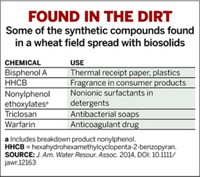Advertisement
Grab your lab coat. Let's get started
Welcome!
Welcome!
Create an account below to get 6 C&EN articles per month, receive newsletters and more - all free.
It seems this is your first time logging in online. Please enter the following information to continue.
As an ACS member you automatically get access to this site. All we need is few more details to create your reading experience.
Not you? Sign in with a different account.
Not you? Sign in with a different account.
ERROR 1
ERROR 1
ERROR 2
ERROR 2
ERROR 2
ERROR 2
ERROR 2
Password and Confirm password must match.
If you have an ACS member number, please enter it here so we can link this account to your membership. (optional)
ERROR 2
ACS values your privacy. By submitting your information, you are gaining access to C&EN and subscribing to our weekly newsletter. We use the information you provide to make your reading experience better, and we will never sell your data to third party members.
Environment
Fungicides Contaminate Western Aquatic Environments
SETAC Meeting News: Fungus-fighting compounds used on crops taint nearby waters and sediments
by Noreen Parks
November 15, 2010

Researchers with the U.S. Geological Survey (USGS) have found a dozen agricultural fungicides in the waters and sediments downstream of farms and orchards in two western states. Presented Nov. 8 at the annual meeting of the Society of Environmental Toxicology and Chemistry (SETAC) in Portland, Oregon, the findings represent the first such data on fungicides in the western U.S.
Farmers routinely use fungus-killing compounds to spray or dust food crops, such as strawberries, corn, and soybeans. Some crops receive up to a dozen doses per growing season. Nationwide, fungicide use has risen considerably since the 1990s, reaching 350 million pounds in 2001. However, the environmental prevalence and effects on wildlife and ecosystems—particularly of newer fungicides—are poorly understood, says Kathryn Kuivila, of the USGS California Water Science Center. Environmental monitoring programs monitor concentrations of few or no fungicides, she notes.
USGS scientists have recently started to measure fungicide levels at a regional scale: They published a survey on streams in southeastern and Midwestern states in October. Extending that research to agricultural areas in the West, Kuivila and her colleagues collected water and sediment samples from sites near three agricultural areas growing potatoes, stone fruits, or lettuce—three crops that, combined, account for half of U.S. fungicide use. Then using techniques including gas chromatography/mass spectroscopy, they looked for 34 fungicides.
In southwestern Idaho, two or more fungicides appeared in almost one-third of the samples from irrigation ditches and streams near a stretch of potato farms. In California's Central Valley, the researchers found that more than half of the water and sediments collected from the San Joaquin River near stone-fruit orchards contained four or more fungicides. Fungicide incidences were similar for lettuce—growing areas of the central California coastland, and preliminary results indicate that crabs and flounder caught in nearby coastal river estuaries have fungicides in their tissues.
While the types of fungicides varied, the scientists identified 18 compounds in the three settings, with six at only trace levels.
Some of these compounds degrade slowly and may persist in the environment for months or years, Kuivila says. Furthermore, "the majority of information on toxicity relates to single compounds, but in combinations they may have additive effects."
Hank Johnson, a hydrologist with the USGS Oregon Water Science Center who was not involved in the study, lauds the research for filling gaps about the environmental prevalence of fungicides and "highlighting the need for additional research and monitoring." He says that the chemicals have received little attention from policymakers and scientists partly because farmers use smaller quantities of them compared to other types of pesticides, and because scientists lack information about their environmental effects.





Join the conversation
Contact the reporter
Submit a Letter to the Editor for publication
Engage with us on Twitter